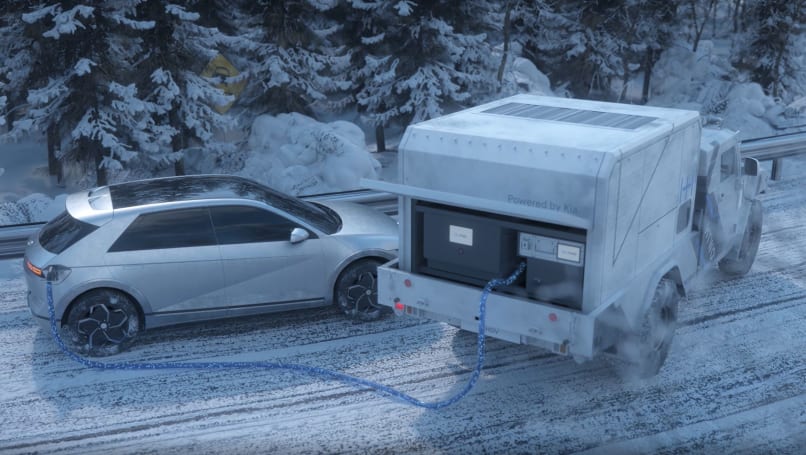
Electricity Is Like Milk, Hydrogen Is Like Cheese: Hyundai Explains Clean Power
BY CHRIS CHILTON | POSTED ON SEPTEMBER 11, 2021
Trying to get your head around the technologies vying to power the next generation of cars can be like trying to buy yourself a new games console and getting totally lost as a hardcore PlayStation fan argues with an Xbox devotee three feet from your face over which is best.
The dominant narrative, the one that seems to have gained acceptance among the public and lawmakers, is that electric power is the future of transport. But while the majority of carmakers are moving towards battery-electric vehicles, another group (including some also selling BEVs) thinks electric cars powered by hydrogen fuel cells are the answer.
But if hydrogen fuel cells just create electricity anyway, what makes them any better than battery cars? On a presentation at the Munich Motor Show in which Hyundai revealed its sporty hydrogen-powered Vision FK and plans to launch two fuel cell powertrains in 2023, the company’s Executive VP and Head of Fuel Cell Center came up with a quirky way of explaining the distinction.
“My good old Japanese friend, Professor Hirose once told me that nomads preserve milk as cheese left over from the summer, and use it as a milk substitute during winter,” said Saehoon Kim. “When a renewable energy society is established, hydrogen will playa similar role to cheese,” he added.
Related: Hyundai Introduces New Hydrogen-Powered Concepts, Including A 671 HP Sports Car
Confused? Kim was referring to the way excess electricity generated by solar or wind power can be converted into hydrogen for storage and transport. Currently, it’s not that easy to store excess electrical energy generated by renewable sources. When wind turbines are cranking hard at night, but our demand for power is low because we’re all in bed with the lights off, that means we’re missing out on loads of free electricity.
Hydrogen: Not Just For Cars
By converting that power to hydrogen it can be stored and used later, either to power our homes and factories or to fuel our cars by employing a fuel cell to turn the hydrogen back into electricity when needed. Hyundai is thinking big, not just about cars, but even getting involved in the production of hydrogen. And Kim hints that if the technology improves, fuel cell power units could be daisy-chained like LEGO blocks to power entire cities. A recent report estimated that green hydrogen could supply 25 percent of global energy needs by 2050.
Homing in on transport, hydrogen technology has huge benefits for bigger cars and particularly commercial vehicles, which would need gigantic (read: heavy and expensive) batteries to work over long distances. With a fuel cell, those some vehicles could travel further and fill up in the same time it would take to fill a conventional gasoline or diesel tank.
Hyundai recently announced plans to introduce 30 of its latest hydrogen-powered Class 8 trucks to the United States. The automaker intends to deliver 30 XCIENT Fuel Cell trucks to California by 2023. Looking further ahead, at Munich Hyundai showed its Trailer Drone concept, which comprised a container carried by a pair of autonomous fuel cell e-Bogies.
Is Hydrogen A Silver Bullet?
A fuel cell works by combining hydrogen with air, and the only emission is water, meaning it’s theoretically great for the environment. But detractors say the process of generating that hydrogen, which may involve fossil fuels, isn’t necessarily quite so ecologically sound, although that situation is improving with growth of green hydrogen created only from renewables.
This summer Hyundai and Kia signed a memorandum of understanding with Canadian company Next Hydrogen Corporation to develop an advanced alkaline water electrolysis system that will help to produce ‘green’ hydrogen economically.
Related: Study Claims Electric Vehicles Are More Efficient, Less Risky Than Hydrogen And E-Fuels

Other issues include the higher cost of filling up a hydrogen car versus a BEV and a more problematic stumbling block, which is the lack of infrastructure. Hydrogen powered cars have been around for decades in prototype form and you can currently buy several models, including the Toyota Mirai and Hyundai Nexo. But the hydrogen infrastructure for refueling FCVs is currently way behind the infrastructure for charging electric ones – and just remember how long that took to get going. There were only 48 operating hydrogen filling stations in the entire United States as of mid-2021, most of them in California, according to the U.S. Department of Energy, though 60 more were either being planned or constructed.
Support Is Building

The good news for hydrogen supporters is that various countries’ governments have pledged to back the expansion of a hydrogen infrastructure. But with no Tesla throwing in money to create fueling stations this time, and without the support of key automotive giants like VW and Stellantis, which have backed away from supporting hydrogen, the process might not be as smooth or rapid as it could be.
And you’ll still get a few loonies posting images of the Hindenburg disaster and claiming they’ll never drive a hydrogen vehicle, while quite possibly cruising round with a bunch of ancient gas canisters in their trunk for a camping trip, or even driving a car converted to LPG by some shop down the road from their house.
So are you down with milk or cheese? Or are you lactose intolerant and quite happy with your ICE car, perhaps running on Porsche’s synthetic fuel?

The Kia RHGV looks tough and goes anywhere, but how close is it to the long-awaited ute from the Korean brand?
Tom White
Journalist
CarsGuide
12 Sep 2021 •
Kia has been notoriously quiet in the last year or so on the idea of its long-awaited pick-up truck, but in a sneaky footnote in Hyundai Group’s Hydrogen Vision 2040 presentation was our latest hint at how tough it could be.
Dubbed the RHGV – for Rescue Hydrogen Generator Vehicle, the Kia-branded concept builds on the previous military transport concepts the brand has shown in the past, but this time as a hydrogen-powered version which carries its own hydrogen generator.
In a teaser video, the brand shows a rendered version of the RHGV reaching remote locations in extreme weather and terrain conditions in order to charge stranded electric vehicles or power remote habitations.

Hyundai Group says the RHGV offers both single-phase 220V and three-phase 380V power supply options via its tray-mounted fuel-cell stacks. It forms part of a concept vehicle onslaught that the brand revealed alongside its vision to build a “hydrogen society” by 2040.
The underpinnings of the RHGV were shown at a defence expo in 2021, sporting a 168kW diesel engine, an eight-speed torque-converter automatic transmission and off-road 4x4 hardware. Its platform was shown to be a modular unit capable of supporting multiple layouts.
Read more Hyundai Group hydrogen news
Do these military concepts preview the 2022 Kia ute?
Kia ute or Hyundai pick-up to be hydrogen powered? Brand says "you will see soon"
Hyundai Group reveals next-gen hydrogen fuel cells: Why hydrogen could be an affordable alternative by 2030
The RHGV is the first we’ve seen of the ladder-chassis-based truck since. The Hyundai Group's R&D boss, Albert Beirmann explained at the reveal of the its e-GMP electric underpinnings in late 2020 that hydrogen was a far better bet for the brand’s commercial offerings than battery-electric.
“If you’re talking about commercial vehicles, pick-up trucks, we are the largest seller of hydrogen fuel-cell vehicles worldwide. That is perhaps a better solution. We are working on it. You will see our solution soon,” he said.
The question is, is the RHGV a version of the consumer-facing solution? Or just a spin-off of a military- and emergency-services-only vehicle? Time will tell, as the brand plans to reveal much more in 2023, at which point its next-generation fuel-cell systems are set to debut.

A smaller but more affordable 100kW output unit will debut in the next-generation Nexo and a fuel-cell version of the Staria people mover, while the Hyundai Group also promised fuel-cell vehicles from both Kia and Genesis before 2025.
We hope we see the ute before then, as at one point the the company has told us it had a target window of 2023. If so, it could be powered by the larger stack, which produces 200kW and is designed for commercial applications.
Stay tuned as we watch Hyundai Group’s next-gen fuel cell developments toward 2023.












